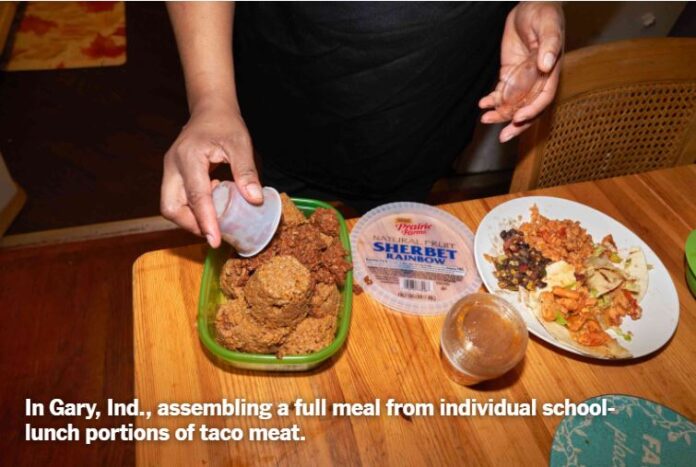Excerpts from an interactive online showing of Brenda Ann Kenneally’s work.
A shadow of hunger looms over the United States. In the pandemic economy, nearly one in eight households doesn’t have enough to eat. The lockdown, with its epic lines at food banks, has revealed what was hidden in plain sight: that the struggle to make food last long enough, and to get food that’s healthful — what experts call ‘food insecurity’ — is a persistent one for millions of Americans.
…
Beginning in May, Brenda Ann Kenneally set out across the country, from New York to California, to capture the routines of Americans who struggle to feed their families, piecing together various forms of food assistance, community support and ingenuity to make it from one month to the next.
…
Food insecurity is as much about the threat of deprivation as it is about deprivation itself: A food-insecure life means a life lived in fear of hunger, and the psychological toll that takes. Like many hardships, this burden falls disproportionately on Black and Hispanic families, who are almost twice as likely to experience food insecurity as white families.
…
Most of the families Kenneally photographed had struggled to feed themselves adequately for years. But she also met families who had been thrown into food insecurity by the pandemic.
…
The federal government’s food-stamp program has been dramatically expanded to confront the economic devastation of the pandemic. But even that hasn’t been enough, as the ranks of the needy grow.
…
In long conversations around the country this August — at kitchen tables, in living rooms and sitting in cars in slow-moving food lines with rambunctious children in the back — Americans reflected on their new reality. The shame and embarrassment. The loss of choice in something as basic as what to eat. The worry over how to make sure their children get a healthy diet. The fear that their lives will never get back on track.
…
“Folks who had really good jobs and were able to pay their bills and never knew how to find us,” says Ephie Johnson, the president and chief executive of Neighborhood Christian Charities. “A lot of people had finally landed that job, were helping their family, and able to do a little better. And then this takes you out.”
…
The causes of chronic food insecurity are many: unemployment; low wages; unaffordable or unstable housing; rising medical costs; unreliable transportation.
…
Treating hunger as a temporary emergency, instead of a symptom of systemic problems, has always informed the American response to it — and as a result government programs have been designed to alleviate each peak, rather than address the factors that produce them.
Food banks are supposed to fill in the gaps, but more than 37 million Americans are food insecure, according to the U.S.D.A. “We call it an emergency food system, but it’s a 50-year emergency,” says Noreen Springstead, executive director of WhyHunger, which supports grass-roots food organizations.
Kenneally’s photographs reveal the fragility of American life, exposed and exacerbated by the pandemic. They show us how close to the edge so many families live, how vulnerable and insecure their arrangements are, and also how resilient they can be when faced with a crisis.
…
But nothing stands out from these images more vividly than the children: eating whatever they can, whenever and wherever they can, somehow managing to maintain, in the midst of this historically desperate time, some innocence and some hope.
…
They are the greatest victims of the food-insecurity crisis. Research has shown long-term links between food insecurity and a wide variety of health issues in children — elevated risks of asthma and other chronic illnesses, lags in educational attainment. And according to a Brookings Institution researcher, the number of U.S. children in need of immediate food assistance is approximately 14 million.
…
For most of these children, the pandemic did not cause the instability that plagues their lives; when it is over, they will face a crisis no less acute, one that has persisted in this country for generations.
In the richest nation on earth, they live at the edge of hunger.
Analysis:
Throughout this interactive article, photographer Benda Ann Kenneally attempts to uncover the effects of COVID-19 on food security with families across the United States. She travels throughout the nation building relationships and photographing the different lived experiences of families and how the pandemic has drastically changed lives, and at the same time revealed a longstanding problem that was already there.
This article reveals unique insights and perspectives that are imperative to consider when moving forward with my project. With an emphasis on addressing a wide breadth of experiences, Kenneally examines the impact of food insecurity during the pandemic on lower-income families who have experienced the system before, families who are entering into food assistance for the first time, the impact on communities of color who have historically been disproportionately affected by hardships, and the effects on children. Addressing a broader range of perspectives moving forward offers a more insightful way of understanding the effects of the pandemic on food access and waste.
Author: Brenda Ann Kenneally
Source: https://www.nytimes.com/interactive/2020/09/02/magazine/food-insecurity-hunger-us.html




